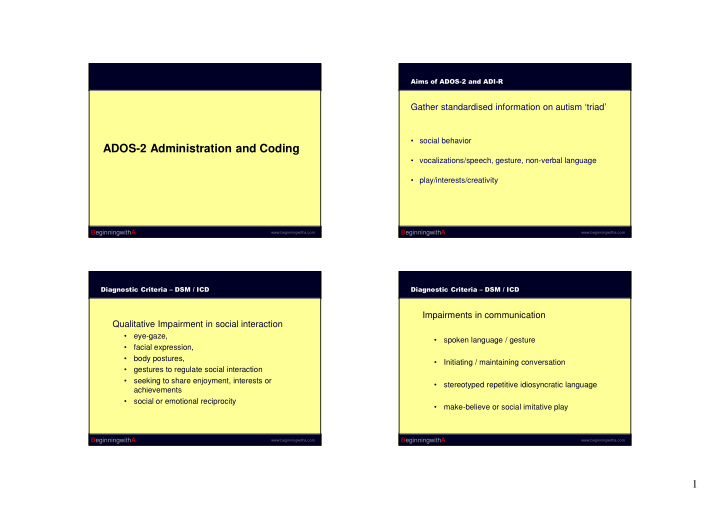



������������������������ Gather standardised information on autism ‘triad’ • social behavior ADOS-2 Administration and Coding • vocalizations/speech, gesture, non-verbal language • play/interests/creativity BeginningwithA BeginningwithA www.beginningwitha.com www.beginningwitha.com ��������������������� ��������� ��������������������� ��������� Impairments in communication Qualitative Impairment in social interaction • eye-gaze, • spoken language / gesture • facial expression, • body postures, • Initiating / maintaining conversation • gestures to regulate social interaction • seeking to share enjoyment, interests or • stereotyped repetitive idiosyncratic language achievements • social or emotional reciprocity • make-believe or social imitative play BeginningwithA BeginningwithA www.beginningwitha.com www.beginningwitha.com 1
��������������������� ��������� ������������������������������ Restricted, repetitive /stereotyped behaviour Must meet criteria A, B, C, and D: • A Persistent deficits in social communication and • encompassing preoccupations, social interaction across contexts • stereotyped and restricted patterns of interest; • B Restricted, repetitive patterns of behaviour, interests, or activities • abnormal in intensity or focus • C Symptoms must be present in early childhood - • inflexible adherence to routines/rituals – but may not become fully manifest until social demands exceed limited capacities • stereotyped and repetitive motor mannerisms • D Symptoms together limit and impair everyday functioning . • persistent preoccupation with parts of objects • E – Not better explained by LD BeginningwithA BeginningwithA www.beginningwitha.com www.beginningwitha.com ��������������������������� � �������!" ����������������������������� • Persistent difficulties in pragmatics or social uses of Autistic Disorder / Childhood Autism verbal /nonverbal communication – difficulties in all three areas age of onset < 36m • affects development of social reciprocity and social Asperger’s Disorder / Syndrome relationships • Persistent difficulties in acquisition /use of spoken / – social interaction deficit, written / other language modalities for narrative and – restricted, repetitive behaviours. discourse • Rule out ASD – no language delay and average cognitive skills – Particularly in respect of restrictive repetitive PDD-NOS / Atypical Autism behaviours • Onset in early childhood – when demands exceed – social impairment capacity – language difficulties or repetitive behaviours, BeginningwithA BeginningwithA www.beginningwitha.com www.beginningwitha.com 2
����������������������#����� $������������ ���������������� ��%�����������$�%��� Expressive Language Level Informant interview (ADI-R) ADOS-2 Module Minimum Maximum • developmental history / events at onset Toddler (12-30 m) No Speech Simple Phrases One (> 30m) • pervasiveness and context Flexible Three Verbally Fluent* Two • phenotypic description Word Phrases* (younger child < 6yrs) Direct observation (ADOS-2) Verbally Fluent Three --------- (older child / younger • context to observe current behaviors adolescent < 16yrs) Verbally Fluent • include parents for young children Four --------- (older adolescent/ adult) BeginningwithA BeginningwithA www.beginningwitha.com www.beginningwitha.com ����&� ����������%������� Behavior of type specified is not present - not necessarily normal 0 Five Domains in Coding Section 1 Behavior of type specified is present, but not sufficiently severe, frequent or marked for code of 2 • Language and Communication 2 Behavior of type specified definitely present and meets specific mandatory criteria • Reciprocal Social Interaction 3 Behavior present to a degree that interferes with functioning or • Play / Imagination / Creativity ordinary life 7 Definite abnormality in general area of coding, but not of type • Stereotyped Behaviours / Restricted Interests specified • Other Abnormal Behaviours 8 Not applicable 9 Not known BeginningwithA BeginningwithA www.beginningwitha.com www.beginningwitha.com 3
��������������'�#������������������ �������(������������������%����� • creates a “social world” in which behaviors related to • Free Play – including Free Play Ball the autism spectrum can be observed if they occur • Blocking Toy Play • Response to Name • Bubble Play – including Teasing Toy Play • Prompts or created opportunities for these behaviours • Anticipation of Routine with Objects – including Unable Toy Play • Response to Joint Attention • Essentially, increasing likelihood of their occurrence • Responsive Social Smile during observation • Anticipation of Social Routine • Functional and Symbolic Imitation • Bath Time – including Bath Time Ignore • Structured hierarchy / some flexibility • Snack BeginningwithA BeginningwithA www.beginningwitha.com www.beginningwitha.com ����������������������%����� ��������������()������%����� • Free Play • Response to Name • Demonstration Task • Response to Joint Attention • Construction Task • Description of Picture • Bubble Play • Response to Name • Telling a Story from a Book • Anticipation of Routine with Objects • Make Believe Play • Free Play • Responsive Social Smile • Joint Interactive Play • Birthday Party • Anticipation of Social Routine • Conversation • Snack • Functional and Symbolic Imitation • Response to Joint • Anticipation of Routine with Attention • Birthday Party objects • Snack • Bubble Play BeginningwithA BeginningwithA www.beginningwitha.com www.beginningwitha.com 4
��������������(*��������%����� ��������������#��������%����� • Construction Task* • Demonstration Task • Construction Task • Conversation and Reporting • Telling a Story from a Book • Cartoons* • Make Believe Play • Emotions • Description of Picture* • Break • Joint Interactive Play • Social Difficulties and • Conversation and Reporting • Daily Living* Annoyance • Demonstration Task • Current Work or School* • Friends and Marriage • Break • Description of Picture • Social Difficulties and • Loneliness • Friends and Marriage • Telling a Story from a Annoyance • Plans and Hopes Book • Loneliness • Emotions • Creating a Story • Cartoons • Creating a Story BeginningwithA BeginningwithA www.beginningwitha.com www.beginningwitha.com �������������������������'�������������*�������� �����������&���������������������� • Read the information with items • Overlap in ASD / developmental delay / PD / psychiatric conditions • Order is flexible • Inter-personal variability in presentation • Be prepared for opportunistic • Intra-personal (developmental) variability administrations (clinical) • Broad criteria • Be aware of ability related items and codings • Variable interpretations of behaviours of interest BeginningwithA BeginningwithA www.beginningwitha.com www.beginningwitha.com 5
Recommend
More recommend